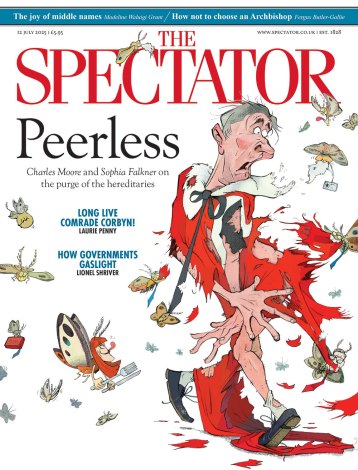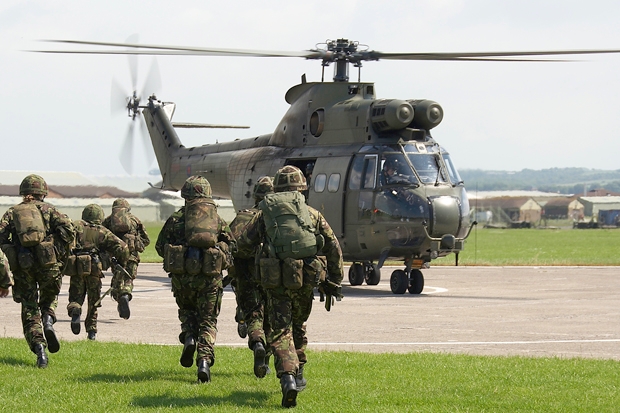It’s not immediately obvious, but the silhouette on the dust jacket — soldiers advancing in single file, on foot (‘boots on the ground’) isn’t one squad, but five soldiers from different campaigns.
From left to right, first comes the British infantryman of the second world war; next is a ‘jock’ from (I think) the Korean war; then a jungle fighter from the Malayan Emergency or the Borneo ‘Confrontation’; then, unmistakably, the long-suffering foot soldier of Operation Banner, the 38-year counter-insurgency (or police action, no one ever quite knew which) in Northern Ireland; and finally, the technology-festooned warrior of Iraq and Afghanistan. Each is a little more erect, a little taller, than the one before, like those profiles of the ascent of man from ape.
The text, however, suggests as much continuity as change, bringing to mind what Ludendorff wrote in his 1919 memoirs: ‘In the end of ends, the infantry is the deciding factor in every battle.’ Montgomery said the same in 1945. Richard Dannatt is in effect saying it too. Surveillance technology and the ability to strike from the safety of distance may be changing the face of warfare, but in the end of ends it boils down to the old story — boots on the ground.
Dannatt tells that story with pace — ‘crisply’ says one of the puffs on the jacket. ‘Corrections will, of course, be made in subsequent editions,’ he writes, in the clipped way of a military briefing. The humour —by turns dry, rueful or soldier’s black — will doubtless be a shade unsophisticated for metropolitan tastes; but the army is still necessarily a world apart, and its way of speaking (when intelligible at all, which it too frequently isn’t, though it certainly is in Dannatt’s book) is that of a more straightforward world. Indeed, unless the army had been another world it could not have done what it did during National Service (1945–1960), the only time in the nation’s history that conscription has obtained in peacetime. National Servicemen kept the Red Army the right side of the Inner German Border, and safely decolonised a large part of the world.
To an extent, the figures tell their own story. In 1945 there were 2.93 million pairs of boots on the ground; in 1960, 258,000. In 1992, with the end of the Cold War, they were reduced to 145,000 pairs (excluding the TA), and by 2001 the number had dropped to 110,000. Now there are just over 80,000, about 10 per cent of them filled by women’s feet.
But Dannatt’s book isn’t meant to be just about this world apart: ‘The history of Britain is the history of her Army and vice versa,’ he writes. What Lord (Peter) Hennessy, the ‘eminent historian… who reviewed the text’, made of that isn’t clear, but it may be true in the same way as ‘No bishops, no king’; though except for a few unhappy years in Cromwell’s time, Britain has never been a Prussia, an army with a country attached to it. Dannatt is relentlessly upbeat:
This book is about a nation’s transformation and adaptation in the decades since the second world war. It could be an elegy to loss, focusing on the ceding of global hegemony and Great Power status, as well as the sunset of empire. Instead, in approaching these issues by considering them in the context of the Army and the Army’s role since 1945, different, more positive, conclusions can be reached.
This Whiggish interpretation of military history will not convince every reader.
Others will be disappointed that there isn’t more description of action. The book is a scholarly narrative and commentary, and Dannatt generously acknowledges the part played by his researcher and drafter, a young female PhD. It is at its most interesting to the general reader, perhaps, when it goes authentically ‘behind closed doors’ — the time at which Dannatt himself was moving from the wings to centre stage.
Having moved centre stage, say his detractors, he then seemed to forget his lines, and began improvising. This he addressed in his autobiography, Leading from the Front, published in 2010 not long after his retirement. He reveals more, now, doubtless aided by the passing of time and the politicians who so plagued him. One reviewer has said that it is not part of Dannatt’s ‘caste or creed to criticise the military leaders who were complicit in Blair’s wars’ (or, he might have added, complicit in wrecking much of the institution under discussion). The clues may be in the index, however. Of the Chief of the Defence Staff at the time of the Iraq invasion, Admiral Sir Michael Boyce, there is nothing. Of the two who followed Boyce during the chaotic occupation of Basra and the adventure into Helmand, General Sir Michael Walker and Air Chief Marshal Sir Graham Stirrup, there is likewise nothing at all.
Perhaps corrections will indeed be made in subsequent editions.






Comments